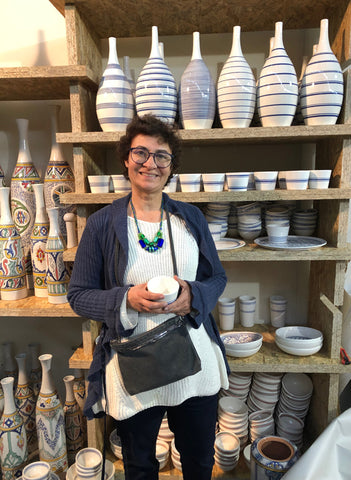Saying yes to Tunisia

Aid to Artisans called me back last month after we'd had a nice conversation about upcoming plans. Was I doing anything the third week in March? Nothing in particular, why? Did I want to go to Tunisia to attend the Handicrafts Creation Fair at the Kram exhibition center? Well, what does one say but of course, when do we leave? After and eleven hour flight to Germany with a couple hours for dinner and then a three hour flight to north Africa, I arrived in Tunis, ready for any kind of sleep. I awoke a few hours later to a sunny morning with a lovely balcony view of the Mediterranean and a delicious buffet of Tunisian breakfast treats.



However, a van was waiting to bring me and my fellow American guests, Kirsten Dickerson from The Fernweh Studio and co-founder of Raven and Lily, and Bethany Whaley, a fashion and lifestyle buyer and fellow entrepreneur, to the Kram exhibition opening, to meet the Prime Minister, Youssef Chahed. After waiting about an hour trying our best not to sneak off and start exploring the artisan booths, the Prime Minister came our way with his entourage and television cameras, and graciously shook our hands. Since the revolution in 2011, Tunisia has had a democratically elected government, and provides free education through college for all its citizens.

The three of us were each assigned a local business student to help translate during our time at the show, who spoke fluent English along with Arabic and French. These young, bright, women were full of enthusiasm for our visit to their country, of which the were very proud. They had similar ambitions to design products and start their own companies, and were excited to accompany us to see what we would learn together.


Aid to Artisans has been working in Tunisia on a project building export capacity for artisans called CAP-X, in partnership with the Institute for Human Development and the Tunisian government. CAP-X aims to create employment opportunities by supporting an increase in Tunisian handicraft exports. This project provides technical expertise to Tunisian artisans to enable them to fine tune their products to meet international standards. Special focus is given to women artisans from underserved areas, including rural areas and the interior regions of Tunisia.




The fair was so large I wasn't sure where to begin, there were over 1000 exhibitors. My translator Oumayma suggested we try to visit all the CAP-X artisans first, which was an excellent suggestion. Along the way we saw traditional basket makers and ceramicists in booths filled with their handmade goods, plus a booth strung with marionettes, a personal favorite. There was a whole wing dedicated to carpets, and another one with towels and another filled with clothing and jewelry. I realized this show would take a few days to properly explore.



In the afternoon, my traveling partner and I took a break to see the traditional Medina marketplace, compared by some to the old city market in Jerusalem. As soon as we entered the ancient city walls, I appreciated the comparison. An abundance of sights and aromas permeated my senses and I was running high on adrenaline as we went from store to store, lead by our noses and intuition. We soon realized we were an easy tourist target for the merchants to spot, and we got invited to see the view from their store's rooftop, where we could also buy more hand woven rugs, on more than one occasion!



The next day we spent learning about the history of Tunisia. First stop was the Bardo Museum, filled with the city's ancient heritage including parts of a palace exquisitely restored, which included an exhibit of contemporary art, so beautifully paired together. The Bardo was the site of a terrorist attack in 2015, and they had a somber memorial in the lobby commemorating the 22 victims who came from multiple countries.




From the Bardo we hopped a cab over to Carthage to see the ancient Roman ruins from the third oldest city in the world, dating back to 814 BC. It was a lovely spring day and the surrounding gardens were lush and filled with the sweetest chirping birds. We strolled by the Mediterranean, 'the sea in the middle of two lands', and watched the fishermen untangle their nets, before taking a lunch break of savory pastries and oranges under the shade.



From Carthage we took the local train filled with families on a Sunday outing to Sidi Bou Said, where we strolled through the white, winding streets accented with blue doors and colorful crowds. I found myself the center of attention as a falcon landed on my shoulder, prompted by its owner who after a few photos demanded ransom money, an easy ploy.
After having had a chance to explore the local markets, our last day in Tunisia was spent back at the fair to place our orders for export. I returned to the artists I had met on my first day whose work continued to impress me. My first stop was at the studio of Mina Ben Miled from Etandart, whose products I had previously purchased at the Aid to Artisans booth at NY Now. I bought some small, thick, wool rugs in mustard and grey colors, along with cotton towels and woven straw placemats. Then back to Le Kram to buy a crate full of contemporary Tunisia pottery from Monia Rassaa at Ekho Design, whose work reminded me of the blue and white villages of Sidi Bou Said, or Corfu, and the French Riviera.




My last stop was to meet Fatma Samat from Kerkenatiss, whose beautiful linen scarves and hand loomed blankets can bring tears of joy to a textile lover. I felt a little tearful saying goodbye to my new found friends, and particularly Oumayma, who represented such hope for this ancient, new country. And just like that, my short visit to Tunisia was over, as I made my way home over the course of the next 18 hours. Thank you Aid to Artisans, Creative Learning, IDH and the Tunisian government for inviting me to your country, which otherwise I may have never seen, had I not said yes.
